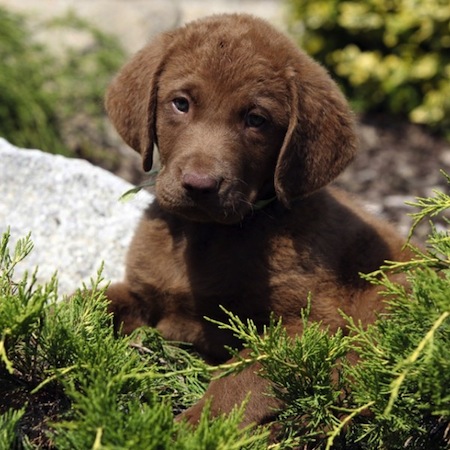n 1897, when two Newfoundland puppies, Canton and Sailor, were rescued from a shipwreck off the Maryland coast, the heritage of the Chesapeake Water Dogs began.
Hunting season on the Chesapeake Bay is cold and stormy, with icy winds and strong tides. The sportsmen needed a tough retriever who could brave the bay’s freezing waters repeatedly to retrieve their game birds when other breeds refused to go. These “Bay dogs” were bred with a coat texture to keep them dry, and the coat is ideally suited for the long, cold swims in rugged conditions. The dogs occasionally had to break ice to gain their birds.
 The Chesapeake Bay Retriever's coat starts at the skin with a dense, wooly undercoat, so thick it is difficult to find the skin when it is parted. It keeps the freezing water from reaching the skin. Layered over it is a short, harsh coat. This double coat holds natural oil, much like the oil on a duck’s feathers. It has a slight oily feel when examined. When a Chessie comes out of the water and shakes, he is barely damp. The coat does not hold water. Overall, the coat is short and thick, not more than an inch to an inch and a half long.
The Chesapeake Bay Retriever's coat starts at the skin with a dense, wooly undercoat, so thick it is difficult to find the skin when it is parted. It keeps the freezing water from reaching the skin. Layered over it is a short, harsh coat. This double coat holds natural oil, much like the oil on a duck’s feathers. It has a slight oily feel when examined. When a Chessie comes out of the water and shakes, he is barely damp. The coat does not hold water. Overall, the coat is short and thick, not more than an inch to an inch and a half long.
The characteristic “Chessie wave” goes down the neck, shoulder, back, and loin only. The hair on the face and legs must be short and straight. There can be feathering on the tail and rear hindquarters. There should be no wave down the sides. A curly coat that covers the whole body is a disqualification. The dog should not be confused with the Curly Coated Retriever or the Poodle. The wave can vary from loose to a light, close wave, sometimes with a kinky appearance. All these varied waving patterns fit the standard; none are preferred.
The Chesapeake coat color encompasses all shades of brown, matching the hunting environment. The deep bittersweet chocolate blends with the mud banks of the bay or river, as the medium milk chocolate melds with the grasses growing along the banks, and the light-yellow “dead grass” coat disappears in the dry, dead wheat stalks and grasses of the autumn fields. Along the Chesapeake Bay in fall, sedge grasses turns bright red, so the sedge-colored Chessie vanishes into the background. Game birds should not notice the camouflaged dog waiting with the hunter in his blind as they fly in.
There are three basic colors. Brown includes all tones from the darkest brown to light cocoa brown. Dead grass includes all the yellow hues of dead grass, from faded tan to dull straw. It can be so light as to seem almost white. Sedge is a red coat color, from bright Irish Setter red, to deep mahogany, to light strawberry-blond. In keeping with the camouflage theme, there can be lighter and darker shades and patterns, including masking, bridling, and saddling. Solid and self-colored dogs are preferred, but varied markings are acceptable.
Disqualifying colors are any black, and white, except for a small area on the chest and belly, the toes, and rear pad. The smaller, the better.
It is important to note that the breed’s color is not particularly important. It counts for only four points in the judging scale, while the correct coat texture counts for 18 points. The double coat texture, the thick undercoat, harsh outer coat, and the oily feel are what protect the dog in the icy water. These are the significant qualities that make up that marvelous Chesapeake coat. —Audrey Austin, American Chesapeake Club, January 2015 AKC Gazette


